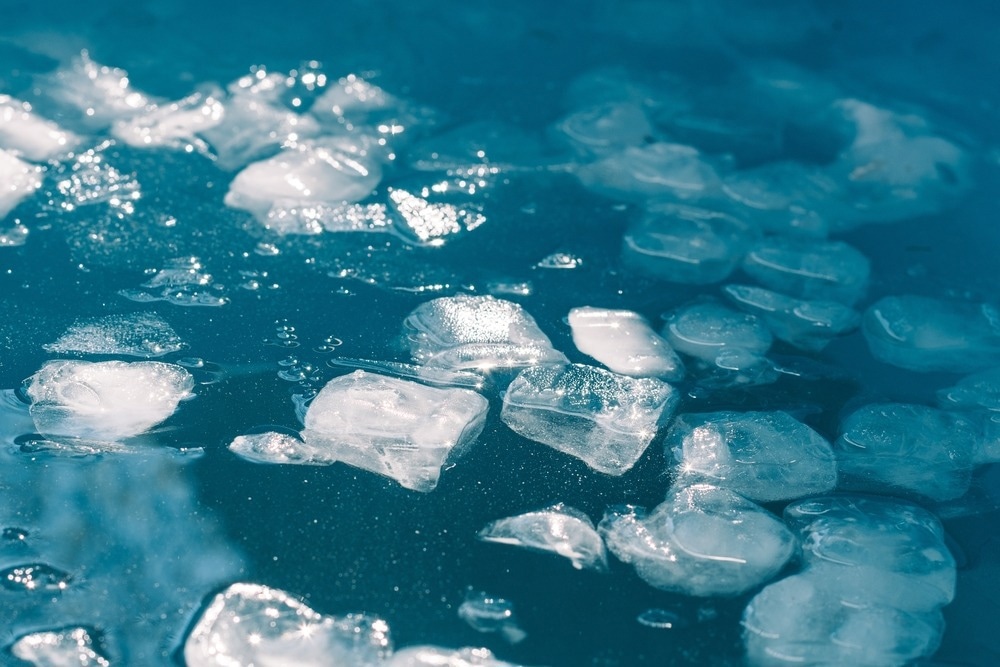Researchers have discovered a phenomenon known as premelting at temperatures significantly lower than previously believed, thanks to imaging equipment at the DOE’s Argonne National Laboratory.

Image Credit: Michele Ursi/Shutterstock.com
A patch of ice can become slick even on a cold, clear day due to premelting. As Michael Faraday initially proposed in the middle of the 1800s, even if the area is frozen, there is some moisture near the surface.
The concept of a premelted layer over ice raises further long-standing queries regarding the phases of water’s transformations, including how it can sometimes undergo all three at once and how it goes from liquid to solid to vapor.
Researchers recently investigated ice crystals that have grown at temperatures below 200 degrees Fahrenheit. The group grew and observed the ice nanocrystals, which were barely ten millionths of a meter wide, at Argonne’s Center for Nanoscale Materials (CNM), a DOE Office of Science user facility.
Aside from revealing the composition of water at subfreezing temperatures, the study also offers a way to investigate delicate materials in molecular detail: low-dose, high-resolution transmission electron microscopy (TEM). A stream of electrons, which are subatomic particles, is directed toward an object via TEM. A detector generates the image by detecting how electrons scatter off an item.
Some materials are beam-sensitive. When you use an electron beam to image them, they can be changed or destroyed.
Jianguo Wen, Study Lead Author and Materials Scientist, Argonne National Laboratory
Electrolytes are a material sensitive to electron beams; they are used in batteries to exchange charged particles. Better batteries could be developed as a result of being able to examine them in great detail without affecting their structure.
However, the low-dose TEM approach was first tested by researchers on frozen water. Water is, after all, inexpensive and plentiful.
Wen added, “Ice is very challenging to image, because it is so unstable under the high-energy electron beam. If we successfully demonstrate this technique on ice, imaging other beam-sensitive materials will be a piece of cake.”
The low-dose method combines a dedicated direct electron detection camera with the aberration-corrected TEM of the CNM. Because of the system’s remarkable efficiency in obtaining information from every electron that strikes a sample, a high-resolution image could be obtained with fewer electrons, causing less damage to the target than would be necessary with a traditional TEM method.
It is feasible to image something as small as an ice crystal in situ, or its natural habitat, because of the low degree of electron exposure. The ice crystals on carbon nanotubes were grown by the study team at 130 degrees Kelvin, or minus 226 degrees Fahrenheit, using liquid nitrogen.
Prior research has detected premelting in the vicinity of the triple point of water. The triple point is where water vapor, liquid, and ice may all exist simultaneously since the temperature is just slightly above freezing and the pressure is low enough. The ice sublimates directly into water vapor at pressures and temperatures lower than the triple point.
The “rules” governing the behavior of water are sometimes concisely encapsulated in a phase diagram, which illustrates the many states of water under various pressure and temperature combinations.
But the real world is much more complex than this simple phase diagram. We showed that premelting can happen far down on the curve, though we cannot explain why.
Tao Zhou, Study Corresponding Author and Materials Scientist, Argonne National Laboratory
Two distinct nanocrystals could be seen melting into one another in an experiment video when the ice is heated to 150 degrees Kelvin, or minus 190 degrees Fahrenheit, under steady pressure. An almost liquid-like coating of ice developed, albeit it was still considerably below freezing. This ultra-viscous water does not fit into any of the phase diagram’s basic lines, which show that water transitions straight from ice to vapor.
The study poses interesting queries that could be investigated with additional studies. What precisely is the liquid-like layer that the researchers observed? What would happen if the temperature and pressure were increased simultaneously?
Could this method open the door to a possible view of “no-man’s land,” the place where extremely cold water abruptly turns into ice crystals? The many states of water have been the subject of centuries of scientific investigation.
The Office of Basic Energy Sciences of DOE funded the study, which was then published in the Proceedings of the National Academy of Sciences (PNAS). Lei Yu, Thomas Gage, Suvo Banik, Arnab Neogi, Henry Chan, Xiao-Min Lin, Martin Holt, and Ilke Arslan of Argonne; Yulin Lin and Aiwen Lei of Wuhan University; and Nathan Rosenmann of the University of Illinois at Chicago are coauthors with Wen and Zhou.
Journal Reference:
Lin, Y., et. al. (2023) Surface premelting of ice far below the triple point. Proceedings of the National Academy of Sciences. doi:10.1073/pnas.2304148120
Source: https://www.anl.gov/